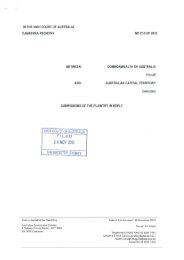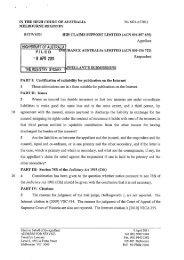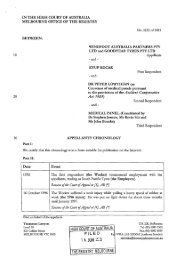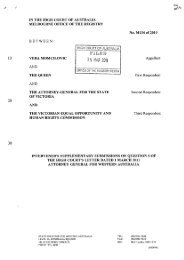Written submissions - High Court of Australia
Written submissions - High Court of Australia
Written submissions - High Court of Australia
Create successful ePaper yourself
Turn your PDF publications into a flip-book with our unique Google optimized e-Paper software.
13<br />
create a tendency to approach the case at a level <strong>of</strong> abstraction which is<br />
divorced from, and may overlook consideration <strong>of</strong>, the factual issues relevant<br />
to the resolution <strong>of</strong> the case.<br />
Inferring Agreement from Participation<br />
54. For the three reasons set out earlier, there was no basis for holding that the failure to<br />
direct as to the element <strong>of</strong> participation was not productive <strong>of</strong> error.<br />
55. In relation to the second <strong>of</strong> these reasons (ie the suggestion that there was no risk <strong>of</strong> a<br />
jury having found an agreement without finding participation because the former cowld<br />
only be inferred from the latter), the <strong>Court</strong> below erred in conflating the quite distinct<br />
10 issues <strong>of</strong> whether (i) there was an agreement to inflict really serious bodily harm or kill<br />
the deceased (and that the slabber was a party to the agreement); (ii) the particular<br />
accused was a party to the agreement; and (iii) the particular accused participated by<br />
committing an act in furtherance <strong>of</strong> the agreement with the necessary foresight.<br />
Different evidence may be admissible in respect <strong>of</strong> each. 53<br />
56. But even if it be accepted that the fact that a person is a party to an agreement may, in<br />
some cases or situations, be inferred from participation, it is another thing altogether to<br />
hold, as the <strong>Court</strong> below did here, that this was the only way the jury could have<br />
reasoned. It is an erroneous holding in circumstances where the jury was expressly<br />
invited to consider finding an agreement based on evidence other than (and prior to)<br />
20 any participation in the brawls.<br />
57. As mentioned, the <strong>Court</strong> below acknowledged (CCA [153]) that the prosecution case<br />
on joint enterprise contemplated an agreement or arrangement that might have been<br />
made (a) at the Duong house, (b) on the way to the Nguyen house, (c) on arrival at the<br />
Nguyen house, or (d) during the brawl as it unfolded at the Nguyen house.<br />
58. Not only was this the prosecution case, but also the trial judge's summing up expressly<br />
invited the jury to find an agreement based upon evidence other than participation. For<br />
example, the trial judge (SU1 04-1 05) expressly raised the possibility <strong>of</strong> the jury finding<br />
that the men, including the accused, at the Duong house had heard reference to a<br />
knife; that they left the Duong house with the aim <strong>of</strong> assaulting the persons at the<br />
30 Nguyen house; that they might have seen and discussed the weapons that their group<br />
had with them. The trial judge continued in a similar vein at SU106 raising various<br />
possible bases for inferring an agreement prior to arrival at the Nguyen house. It was<br />
53<br />
Hand/en v The Queen (2011) 86 ALJR 145 at [4], [54]-[55]; Tripodi v The Queen (1961) 104 CLR 1 at 6-7;<br />
Ahem v The Queen (1988) 165 CLR 87 at 94-95, 99; Gillies, The Law <strong>of</strong> Criminal Complicity (1980), pp259-266.
















